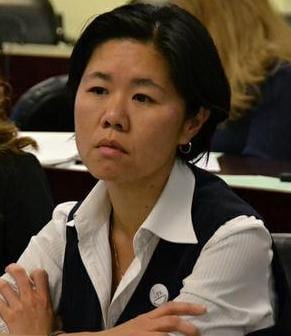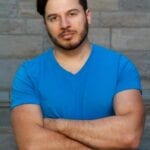
The area of central Toronto in question. Credit: Andrea Houston

Kristyn Wong-Tam is the councillor for Ward 27, home to the gay village. Credit: Andrea Houston
Residents of the Church-Wellesley Village could find their political voice diminished if a proposed federal riding redistribution that cuts Toronto Centre in half along Wellesley St goes ahead, some residents fear.
Under a law passed in December 2011, Ontario, Alberta, British Columbia and Quebec are receiving additional seats to account for population growth and their growing proportion of Canada’s population. Ontario gets 15 seats, Alberta and BC get six new seats each, and Quebec gets three additional seats.
The new seats are being added as part of the automatic decennial review of electoral boundaries to account for population shifts reported in the census.
The non-partisan judicial panel that proposes electoral boundaries is squeezing most of Ontario’s new ridings into the Greater Toronto Area, which is experiencing the fastest population growth and was the most underrepresented area in the province. Toronto itself is gaining 2.5 new seats (a riding formerly shared with Peterborough has been abolished), while 9.5 new ridings are being added to the fast-growing 905 communities. The remainder are in Cambridge, Ottawa and Barrie.
Ridings in downtown Toronto are being shrunk largely in response to the condo boom that has brought tens of thousands of new residents to the area. A new riding called Mount Pleasant is proposed, which will include the part of the current Toronto Centre riding north of Wellesley St between Sherbourne and Queen’s Park, and stretching north to Eglinton Ave, including the more affluent neighbourhoods of Rosedale, Moore Park, Yorkville and Deer Park.
The proposal effectively splits the Church-Wellesley neighbourhood – long a centre of queer activism – in half between the two ridings. This division seems to go against the spirit of the Electoral Boundaries Readjustment Act, which says “the commission shall consider . . . the community of interest or community of identity in or the historical pattern of an electoral district in the province” in determining reasonable electoral district boundaries.
For Robert Fabian, one of the leaders of the Church-Wellesley Neighbourhood Association, the proposed division of the community among two MPs would make it more difficult for the group to have access to an elected official.
“My experience is that it takes a fair amount of time to establish a relationship with an elected official. It doesn’t happen overnight. I just see a doubling of that challenge,” he says.
Fabian says he will encourage the CWNA to petition the commission to adjust the boundary to maintain the entire Church-Wellesley neighbourhood in one riding, with the boundary being moved north to Charles or Bloor streets, or south to College/Carlton streets.
“My own instincts would argue for having it part of the more downtown, urban Toronto Centre,” he says. “Moore Park and Rosedale are clearly upscale, above-average-income ridings. To the extent that downtown neighbourhoods have encouraged diversity, it makes more sense to stay downtown. Rosedale does not encourage diversity.”
The federal redistribution will have knock-on effects for the province, because under Ontario law, provincial ridings in Southern Ontario are defined to be the same as federal ridings unless Queen’s Park changes them.
Casey Oraa, vice-chair of the activist group Queer Ontario, says the organization may consider making a submission to the commission about the proposed changes.
“It’s hard to predict the impact of the redistribution,” he says. “If you look at the Village itself, it’s going through changes and gentrification. The landscape of the Village is changing.”
For current MPP Glen Murray, using Wellesley as the riding boundary is “problematic.”
“One of the principles of redistribution is that you respect the boundaries of significant neighbourhoods,” he says. “The Church-Wellesley neighbourhood is a very strong neighbourhood.
“You want political boundaries that allow you to work effectively as an MP and so that neighbourhoods can work effectively with government. The gay and lesbian community — Church-Wellesley is a historic area for the community in Toronto. You wouldn’t want to divide it.”
Murray says he’ll meet with city councillors Kristyn Wong-Tam and Pam McConnell, who represent the area, and with neighbourhood residents and business associations to consider making a joint submission to the commission about the new boundary.
Municipal ward boundaries are currently federal ridings cut in half, but there is no automatic mechanism that forces the city to adjust its electoral map along with the federal government. Mayor Rob Ford has instead pledged to reduce the number of city councillors from 44 to 22. But Murray says that adding representatives will be beneficial to Toronto and Ontario residents on the whole.
“Ontario is so underrepresented [in Parliament],” he says. “I’m quite happy that the folks in downtown Toronto have another voice now, because it will be better represented.”
Murray says that if he wins the next provincial election for Toronto Centre after redistribution, he’ll have more time to work on constituency issues, because he’ll have fewer constituents.
“I’ll have twice as much time as I would before. I’m really looking forward to that because my favourite part of the job is working with residents,” he says.
The commission will have public hearings on its proposal before sending its recommendations to the House of Commons in February 2013. A parliamentary committee will review the recommendations and send any objections back to the commission. The commission will then decide whether to make modifications before the chief electoral officer makes the representation order, which will be used for the next general election, scheduled for 2015.
Get Involved:
You can make a submission to the commission at public hearings scheduled for Nov 14 at North York Civic Centre and Nov 15 at Metro Hall. If you wish to speak, you must notify the commission by email at ontario@rfed-rcf.ca before Oct 1.
For more information, click here.


 Why you can trust Xtra
Why you can trust Xtra


